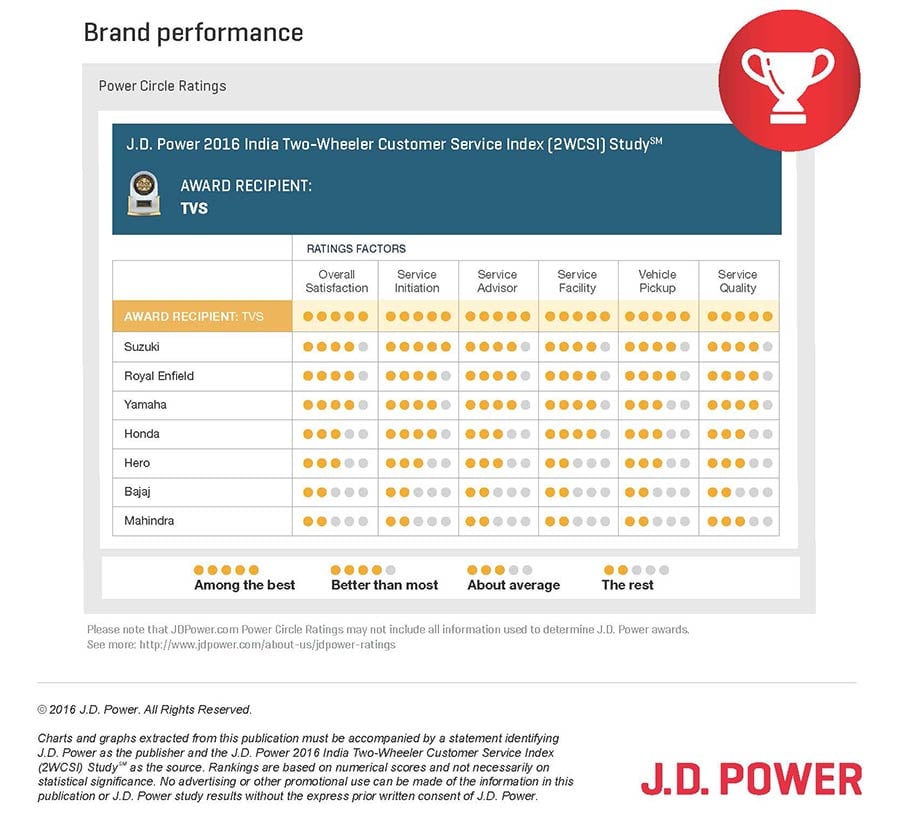How Bike makers Score on After-sales service experience

Two-wheeler dealers in India face significant competitive pressure from independent workshops, which are providing similar service work as the original equipment (OE) authorized network, according to the J.D. Power 2016 India Two-Wheeler Customer Service Index (2WCSI) Study,SM released today. More than one in five (22%) two-wheeler customers indicate visiting an independent workshop during the warranty period.
The inaugural study measures customer satisfaction with the after-sales service experience at original equipment (OE) authorized service center during the first 12-24 months of ownership. The study focuses on what matters most to customers when they take their two-wheeler in for service and also analyzes the processes that define the service experience. The study measures overall satisfaction in five factors (listed in order of importance): vehicle pick-up (22%); service advisor (21%); service quality (20%); service facility (19%); and service initiation (18%). Overall customer satisfaction is measured on a 1,000-point scale, with a higher score indicating higher satisfaction.
Satisfaction with the service experience at an authorized network is driven by three after-sales service- related activities, including the charges incurred, quality of work done and on-time delivery after service. According to the study, 25% of customers are dissatisfied with these activities, creating the need to improve on these services since there is significant correlation between customers visiting an independent workshop and the quality of experience at the authorized network.
“Given the high propensity of customers visiting independent workshops, it is critical for manufacturers and their authorized network to develop a differentiated service experience, thus providing a compelling reason for customers to revisit,”
said Mohit Arora, executive director at J.D. Power.
“Significant opportunities for improvement exist related to key customer expectations of quality, cost and time. Dealerships that are able to address these efficiently and engage customers are likely to benefit from increased service business.”
Rankings
TVS ranks highest in customer satisfaction with after-sales service with a score of 773, performing particularly well in all five factors. Suzuki (764) ranks second and Royal Enfield ranks third (758).
Key Findings
Overall and Segment Satisfaction: Overall customer satisfaction with two-wheeler after-sales service is 748. In the two-wheeler segments, the CSI score averages 755 for scooters and 745 for motorcycles.
Factors Most Influencing Customer Satisfaction: Among the five study factors, satisfaction is highest in service facility (758) and lowest in vehicle pick-up (738).
Location of Service Facility Impacts Satisfaction: Proximity of the service centre impacts satisfaction. Among the 65% of owners who travel 5 or fewer kilometres to reach the service centre, satisfaction is 12 points higher than among the 19% of owners who travel 10 or more kilometres (751 vs. 739, respectively).
Scheduling of Service Improves Satisfaction: Satisfaction is higher among customers who schedule their service than among those who drop by the service dealer without an appointment (773 vs. 742, respectively).
Highly Satisfied Customers More Likely to be Loyal and Advocates: Highly satisfied customers tend to have higher levels of advocacy and loyalty to the service dealer. Among highly satisfied customers (overall satisfaction scores of 857 or higher), 67% say they “definitely would” recommend their service dealer to family and friends, while only 22% of highly dissatisfied customers (scores of 667 or lower) say the same. Additionally, 58% of highly satisfied customers say they “definitely would” revisit their service dealer for post-warranty service, compared with only 21% of highly dissatisfied customers.
“Understanding after-sales service expectations and concerns can help service dealers build a more engaging relationship with customers,”
said Kaustav Roy, director at J.D. Power.
The 2016 India 2WCSI Study is based on evaluations from 7,270 two-wheeler owners in 45 cities across India. These owners purchased a new two-wheeler between November 2013 and March 2015 and had a service experience within three months of evaluation. The study includes 10 two-wheeler makes and over 75 two-wheeler models and was fielded from November 2015 to March 2016.







